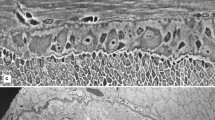Abstract
The complex nervous networks found throughout the mammalian gut—the enteric nervous system—are histologically, ultrastructurally, and, to some extent, functionally—similar to the central nervous system1–3. The glial cells of the small enteric ganglia are generally classified as Schwann or satellite cells, since they are found in the peripheral nervous system, possess nuclei which ultrastructurally resemble those of Schwann cells and are derived from the neural crest4,5. However, it has been argued that these cells resemble astrocytes of the central nervous system with respect to gross and fine structure, and their relationship with the enteric neurones and their processes1,6. In immuno-histochemical studies of these cells, both in frozen sections of gut wall and in tissue culture preparations of the enteric plexuses, we found evidence that the enteric glial cells are rich in glial fibrillary acidic protein (GFAP), a protein associated with the 100 Å glial intermediate filaments7, and hitherto believed to be specific to astrocytes of the central nervous system only8,9.
Similar content being viewed by others
References
Gabella, G. J. Anat. 111, 69–97 (1972).
Wood, J. D. Physiol. Rev. 55, 307–324 (1975).
Wood, J. D. in Integrative Functions of the Autonomic Nervous System (eds Brooks, C. M, Koizumi, K. & Sato, A.) 177–193 (Elsevier, Amsterdam, 1979).
Schofield, G. C. in Handbook of Physiology Vol 4 (ed. Code, G. F.) 1579–1627 (Williams and Wilkins, Baltimore, 1968).
Cook, R. D. & Burnstock, G. J. Neurocytol. 5, 195–206 (1976).
Gabella, G. Zeitschrift für Naturforschung, 26 b, 244–245 (1971).
Schachner, M., Hedley-Whyte, E. T., Hsu, D. W., Schoonmaker, G. & Bignami, A. J. Cell Biol. 75, 67–73 (1973).
Bignami, A., Eng, L. F., Dahl, D. & Uyeda, C. T. Brain Res. 43, 429–435 (1972).
Dahl, D. & Bignami, A. Brain Res. 116, 150–157 (1976).
Pruss, R. Nature 280, 688–690 (1979).
Antanitus, D. S., Choi, B. H. & Lapham, L. W. Brain Res. 89, 363–367 (1975).
Jessen, K. R., McConnell, J. D., Purves, R. D., Burnstock, G. & Chamley-Campbell, J. Brain Res. 152, 573–579 (1978).
Raff, M. C. et al. Brain Res. 174, 283–308 (1979).
Anderton, B. H., Thorpe, R., Cohen, J., Selvendran, S. & Woodhams, P. J. Neurocytol. (in the press).
Lazarides, E. Nature 283, 249–256 (1980).
Ludwin, S. K., Kosek, J. C. & Eng, L. F. J. comp. Neurol. 165, 197–208 (1976).
Author information
Authors and Affiliations
Rights and permissions
About this article
Cite this article
Jessen, K., Mirsky, R. Glial cells in the enteric nervous system contain glial fibrillary acidic protein. Nature 286, 736–737 (1980). https://doi.org/10.1038/286736a0
Received:
Accepted:
Issue Date:
DOI: https://doi.org/10.1038/286736a0
- Springer Nature Limited
This article is cited by
-
TGFβR-1/ALK5 inhibitor RepSox induces enteric glia-to-neuron transition and influences gastrointestinal mobility in adult mice
Acta Pharmacologica Sinica (2023)
-
Effects of experimental ulcerative colitis on myenteric neurons in P2X7-knockout mice
Histochemistry and Cell Biology (2023)
-
Inhibition of platelet activation suppresses reactive enteric glia and mitigates intestinal barrier dysfunction during sepsis
Molecular Medicine (2022)
-
Inhibition of platelet activation suppresses reactive enteric glia and mitigates intestinal barrier dysfunction during sepsis
Molecular Medicine (2022)
-
Enteric glia: extent, cohesion, axonal contacts, membrane separations and mitochondria in Auerbach’s ganglia of guinea pigs
Cell and Tissue Research (2022)





